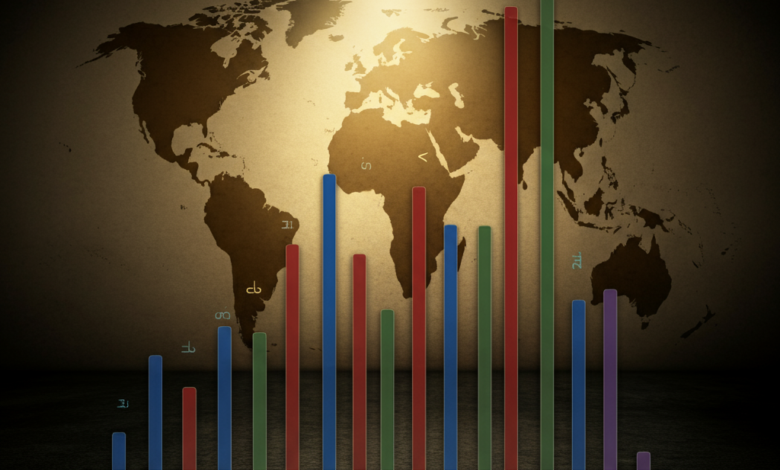Country Bar Race by Military Power (1901-2020): A Century of Shifting Dynamics

The evolution of military power, spanning over a century, has been both a driver and result of the major socio-political transformations that have shaped the modern world. From the dawn of the 20th century to the rise of technological giants in the 21st, the “race” in military power has underpinned global power struggles, alliances, and groundbreaking advancements. This blog explores the key moments, players, and metrics of military strength over the years, as well as their broader implications.
Whether you’re a political science scholar or an avid history enthusiast, this piece will offer you a fascinating insight into the shifting sands of global military power from 1901 to 2020.
A Historical Analysis of Military Power (1901–2020)
The century between 1901 and 2020 can be divided into pivotal phases that map the ebbs and flows of global military power races. Each era marks a turning point defined by technological, political, and social factors that determined which nations led the charge in military prowess.
The Early 20th Century (1901–1945)
At the beginning of the 20th century, the world’s military dynamics revolved around imperial powers. The British Empire, boasting a dominant naval force, stood unmatched. The German Empire was on the rise, setting the stage for global friction.
World War I (1914–1918) disrupted long-standing structures, with technological innovations like tanks, chemical warfare, and aircraft revolutionizing combat. After the war, the Treaty of Versailles weakened Germany, both militarily and politically.
World War II (1939–1945) brought enormous shifts. The industrial and military might of the United States emerged robustly, while Nazi Germany and Imperial Japan showcased unprecedented levels of technological militarization and strategy. This period also marked the arrival of the Soviet Union as a formidable player.
The Cold War Era (1945–1991)
Post-World War II, the world was divided into two military superpowers—the United States and the Soviet Union. The Cold War heralded a nuclear arms race, placing these two rival nations at the forefront of global military power. NATO and the Warsaw Pact emerged, leading to a period marked by proxy wars, brinkmanship, and rapid technological evolution.
The Vietnam War, the Korean War, and the Soviet war in Afghanistan were pivotal, placing military strength into broader ideological contexts such as the fight between capitalism and communism.
The Post-Cold War Period (1991–2020)
The collapse of the Soviet Union reshaped global military power. The United States emerged as the singular superpower, with massive defense spending unmatched by any other nation. However, the emergence of China as an economic and military powerhouse, alongside Russia’s military modernization efforts, challenged U.S. dominance.
The War on Terror (post-9/11) led to asymmetric warfare shaping global military efforts. Technology-driven advancements, including drones, cyberwarfare, and artificial intelligence, started defining military strength more than sheer manpower or nuclear arsenals.
How Do We Measure Military Power?
Understanding military power goes beyond mere troop numbers. It requires a nuanced approach that includes metrics such as technological advancements, defense budgets, and personnel quality. These criteria have evolved dramatically between 1901 and 2020.
Key Metrics of Military Strength
- Defense Spending
The overall defense budget reflects a nation’s investment in maintaining and advancing its military. For instance, the United States annually spends more on defense than the next 10 countries combined.
- Technological Innovation
From precision-guided missiles to hypersonic technology, innovation plays a critical role in determining military capability. Cyber capabilities, modern warfare AI, and space militarization are increasingly prominent metrics.
- Personnel and Logistics
The size, training, and readiness of a nation’s armed forces, alongside its logistical capacity, influence military power. This includes the ability to deploy forces globally.
- Geopolitical Influence
Military alliances, like NATO or regional groupings, amplify a country’s power by creating multilateral capabilities.
- Nuclear Arsenal
Deterrence policies and the size of nuclear stockpiles, as seen during the Cold War, remain a critical factor in global military equations.
Case Studies of Military Power Shifts
While many nations have engaged in this “country bar race by military power” between 1901 and 2020, a few countries provide particularly illustrative stories of ascent and adaptation.
The United States
The United States rose to unmatched prominence during World War II, leveraging its economic strength to become a leading global force. Post-Cold War dominance was further cemented with continuous technological advancements and significant investment in defense, making the U.S. a global enforcer in the 21st century.
The Soviet Union/Russia
Russia’s story is one of rise, fall, and resurgence. Post-World War II, the Soviet Union became a global superpower, only to lose its foothold with its collapse in the early 1990s. However, under Vladimir Putin, Russia has re-invested in military strength, from modernizing its navy to wielding influence through hybrid warfare.
China
China’s meteoric rise is one of the most compelling global shifts. From a largely agrarian economy in 1901 to one of the world’s largest military powers by 2020, China’s strategy has combined economic might with military modernization. Investments in naval strength and technologies like quantum computing have made China a formidable player in the global race.
Future Projections for Global Military Dynamics
Looking beyond 2020, emerging technologies like artificial intelligence, quantum computing, and space exploration will likely reshape global military dynamics. Collaboration in defense innovation—such as NATO initiatives—will remain critical, while smaller nations will have opportunities to punch above their weight through cyber capabilities.
However, military power will increasingly tie into other factors, like economic resilience and energy independence. Countries leading in clean energy technology might wield economic and geostrategic influence that outpaces traditional military power.
The question remains—will the global military race foster innovation and stability, or will it escalate conflicts in an already fragmented world order?
The Ever-Evolving Race for Military Power
Military power has always been a central pillar of global influence, shaping alliances, determining outcomes of diplomatic stand-offs, and rewriting borders. Analyzing the country bar race by military power from 1901 to 2020 provides valuable insights into the intricate web of international relations and power dynamics.
Which nation will dominate the next chapter of military evolution? That remains to be seen, but this century’s race will undoubtedly be one tethered to advancements in emerging technologies and shifts in global geopolitics.



